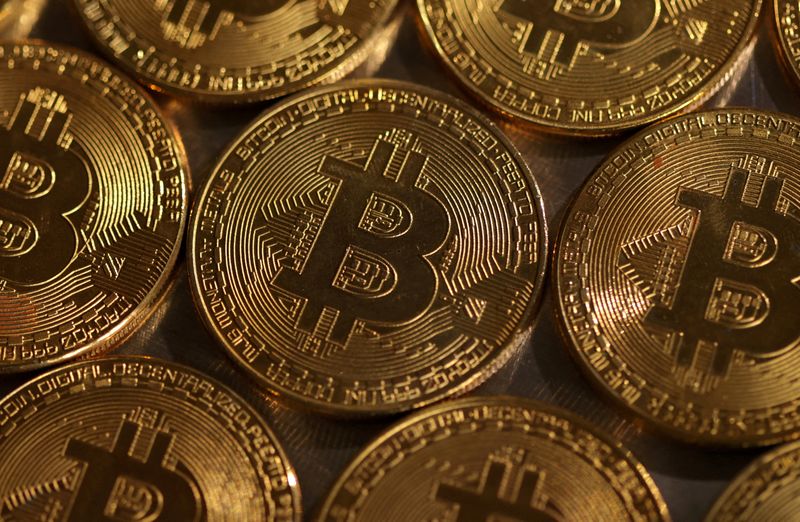Month: March 2024
Will Bitcoin Transform into Just Another Stock Amidst Institutional Surge and ETF Integration?
Steering through a sea of change in the crypto market, the investment game is experiencing a seismic shift. Spot Bitcoin ETFs already exist, signaling Bitcoin’s leap into mainstream finance and knitting it closer to conventional investment fabrics. We’ll look at the tip of the iceberg trying to imagine its true depth as well as the current correlation between Bitcoin, stocks, and Gold. We’ll attempt to figure out if the traditional market is really leading Bitcoin out of its decentralized place, or if there’s still an avenue for hope that it can maintain its unique path.
According to the Kaiko data, Bitcoin’s risk-adjusted returns were superior to traditional assets. Nvidia led with the highest returns on a risk-adjusted basis, while Bitcoin impressively trailed just behind, outpacing major traditional assets like the S&P 500, Gold, with its value surging over 160% in risk-adjusted terms.
Source: Kaiko Research
Meanwhile, according to the IMF Crypto Cycle and US Monetary Policy study, 80% of variation in crypto prices and its increasing correlation with equity markets coincided with the entry of institutional investors into crypto markets since 2020. In particular, trading volumes by institutions on crypto exchanges grew by more than 1,700% (from roughly $25 billion to more than $450 billion) during the second quarter of 2020 and the second quarter of 2021. According to the study, the US monetary policy affects the crypto cycle, just like global equity cycles, but surprisingly, only the US Fed’s monetary policy matters, not the other major central banks – probably because crypto markets are highly USD-dependent.
Furthermore, the 2023 Institutional Investor Digital Assets Outlook Survey indicates that 64% of investors are set to up their stakes in the crypto sphere within three years, allocating up to 5% of AUM to crypto. It said a number of institutions made investments for the first time over the past year, while others increased their existing investments. While the study highlights a surge in crypto commitment from 41% of asset managers, only 27% of asset owners seem to be ramping up their stakes.
Although Bitcoin was born from the idea of spreading power equally, recent studies indicate that it’s slowly becoming dominated by a select few big players.
Changing Correlation Dynamics
Interestingly, Bitcoin moves in sync with the S&P 500 and Nasdaq, with an impressive correlation. Meanwhile, the correlation between Bitcoin and Gold has sharply decreased recently, contrasting with claims that investors see crypto as a safe haven or hedge against inflation, a role traditionally played by Gold.
Source: TheBlock
Notably, Bitcoin’s correlation with Gold was positive at 0.83 on November 7, 2023, but decreased to -0.1 on January 10, 2024, before rebounding to a marginally higher positive level 0.14 on February 9, 2024. In the meantime, Bitcoin’s relationship with the S&P 500 saw a negative correlation of -0.76 on November 11, 2023, and then hit a positive correlation of 0.57 in January 2024. Ths shift from negative to positive correlation points to Bitcoin’s changing perception among investors.
The Nasdaq Composite, known for its technology and growth stocks, also displayed a variable correlation with Bitcoin. The negative correlation, of -0.69 on October 30, 2023, shifted to positive 0.44 in January. It seems traders are linking Bitcoin’s rhythm to the tech sector’s pulse, hinting at a new kinship in investment strategies.
When the correlation between Bitcoin and traditional equity markets like the S&P 500 and Nasdaq increases, while its correlation with Gold decreases, it suggests that Bitcoin is behaving more like a risk-on asset rather than a safe haven. When investors are feeling venturous, they often swing toward stocks and digital coins for the chance at juicier profits.
If institutional and retail investors are increasingly involved in both equity and cryptocurrency markets, their simultaneous buy and sell decisions could cause the price movements of these assets to align.
Spot Bitcoin ETFs getting the green light seem to be ramping up its charm for big-time investors, with a solid chunk already planning to boost their Bitcoin game. Bitcoin’s move into ETFs might make it act more like stocks since those funds are big players in the stock world.
Amidst these developments, the essence of Bitcoin and other cryptocurrencies, free from the confines of traditional financial systems, could be undermined. Moreover, these shifts could expose Bitcoin to the very systemic risks from which it was designed to escape.
Closing Thoughts
As we look at how spot Bitcoin ETFs might shake up Bitcoin’s role in the market and its current tie to stocks, we need to keep a sharp eye on balancing our excitement for more big players jumping in and the possible growth with staying true to Bitcoin’s core principle of not being centrally controlled. Bitcoin’s move toward a more centralized investment scene could stir the market, offering bright opportunities, but also tough challenges ahead.
This is a guest post by Maria Carola. Opinions expressed are entirely their own and do not necessarily reflect those of BTC Inc or Bitcoin Magazine.
US Government Continues Bitcoin Seizures, Controls Nearly 1% of Circulating Supply
The below is an excerpt from a recent edition of Bitcoin Magazine Pro, Bitcoin Magazine’s premium markets newsletter. To be among the first to receive these insights and other on-chain bitcoin market analysis straight to your inbox, subscribe now.
The United States federal government has once again added to its substantial Bitcoin hoard, transferring $922 million worth from wallets associated with Bitfinex hackers in a seizure.
Over the course of a series of various seizures and other asset forfeitures, the United States federal government has accumulated and holds enough Bitcoin to unquestionably count as one of the largest whales. In the earliest days of the Bitcoin scene, the overwhelming crypto-anarchist spirit among the community led to a series of various extralegal business ventures, most famously the Silk Road. This overtly illegalist era of the industry is more or less completely over, but the success of these early ventures accumulated massive amounts of Bitcoin: which has in time been accumulated by the US government.
The Silk Road alone has been at the center of several massive seizures from law enforcement agencies, with the site’s actual coffers far from the only source. On multiple occasions over the last few years, various hackers who robbed the Silk Road have in turn seen their assets seized and added to the federal government’s massive stockpile. Even though hundreds of millions of bitcoins from this source have already been sold at government auctions or through other means, there are still billions left to go. For their part, law enforcement agencies seem to be in no hurry to wash their hands of these assets.
On February 29, the stockpile grew once again when the government moved more than 15k bitcoins from the wallets of two Bitfinex hackers. The hackers, Ilya Lichtenstein and Heather “Razzlekhan” Morgan, recently testified about their 2016 hack of Bitfinex, which ranks as one of the most profitable heists of all time with nearly 120k bitcoins stolen. Bitfinex, one of the oldest still-operating exchanges in the entire crypto ecosystem, is still a prominent service, but their operations still bear lingering scars from a theft of this magnitude. For one thing, US citizens are completely forbidden from accessing the platform, along with citizens from several other countries. Perhaps it is for this reason that the Justice Department has refused to state whether or not the government intends to reimburse Bitfinex’s 2016 customers, who actually had their money stolen.
Regardless of what the government’s plans are with this money, a seizure like this has once again highlighted the sheer size of the federal government’s Bitcoin reserve. Thankfully, the government’s dealings with these assets are all a matter of public record, and Bitcoin transactions themselves are all completely transparent on the blockchain. For this reason, analysts are confident in the claim that the United States holds just shy of 200k bitcoins, worth approximately $12.1 billion. This makes them unmistakably one of the largest whales out there, with only Binance and Satoshi holding greater amounts. In fact, the government currently holds nearly 1% of all Bitcoin in circulation. Regardless of claims that prosecutors have no interest in maximizing profits when disposing of these assets, it’s undeniable that the government holds substantial leverage over the whole space.
These seizures are particularly interesting due to some recent comments made by exiled whistleblower Edward Snowden. Specifically, considering the rising global acceptance of Bitcoin in regulation and traditional finance, Snowden predicted that “A national government will be revealed this year to have been buying Bitcoin—the modern replacement for monetary gold—without having disclosed that fact publicly”. If Bitcoin is the digital gold, after all, it would only make sense that powerful nations would want to build up reserves. The strategy has famously worked for the Salvadoran president, Nayib Bukele, who greeted the new bull market with a declaration that his country’s Bitcoin investment has gone up by 40% since the initial purchases. Not, of course, that he plans to sell.
In any event, Snowden’s comments seem especially relevant in that the United States hasn’t actually purchased any of the Bitcoin it currently holds. Even though the government has a theoretical responsibility to dispose of these assets, the pace as of yet has been glacial, and in the meantime, it would be extremely straightforward for Congress to halt these sales. All it would take is a desire for the policy to change, and a genuine Bitcoin reserve could spring up overnight. This is the crux of Snowden’s specific prediction that governments will acquire Bitcoin secretly and that the government has ample plausible deniability. We don’t have a reserve; we just happen to be reserving these assets for a later sale. There is nothing suspicious about that!
If a government did actually want to acquire massive quantities of Bitcoin in secret, it would run into a great number of transparency problems caused by the trustless nature of Bitcoin’s blockchain. The anonymous “Mr. 100” has made headlines throughout the month of February, acquiring a mind boggling 100 BTC per day and reaching the status of the 15th largest whale. As chain analysts have tried to determine the buyer’s identity, speculation has already begun that a national government is the culprit. Based on the timing of the purchases and several other factors, the buyer is likely in Asia, specifically the Middle East. Qatar, the United Arab Emirates, Saudi Arabia—all these are strong candidates to be the coins’ rightful owners.
In other words, if a government wishes to build up a Bitcoin reserve, it might be easier to seize the assets outright rather than buy them at fair value. After all, if the transactions will be recorded on the blockchain either way, why not save their money? The UK seems well-positioned to build up a stockpile in this way like the Americans, having seized $1.77 billion in January. Not only were these bitcoins seized from a foreign national currently on the run, with no recourse to recoup these funds, but the British government has subsequently passed legislation deepening its power to seize or freeze cryptocurrency assets. It wouldn’t take much to start building up a notable hoard in its own right.
By this point, the days when Bitcoin’s core community held a defiant attitude towards law enforcement are a distant memory. Although people can commit crimes centered around Bitcoin just like they can with any other currency, the fact of the matter is that Bitcoin is only becoming more legitimate for the world’s governments. US regulators approved a Bitcoin ETF, and other countries are falling like dominoes to endorse it themselves. Eventually, it’ll be a necessity for powerful governments to stay on par with their competitors and maintain their own reserves of Bitcoin. The US, after all, controls nearly 1% of a massive industry with substantial leverage over it. Are they going to be the only country with this leverage? It may be difficult for any nation to build up these stockpiles in secret, but even so, the race has already begun. No matter who wins it, it’s Bitcoin that will be on top in the end.
Asia FX muted, dollar steady with Powell, payrolls in focus
Post Content
Bitcoin bounces beyond $64,000 as records beckon
Post Content
Dollar dips on weak data, yen hurt by cautious BOJ
Post Content
Final Agreement On EIA Emergency Survey Released
The final agreement between the Texas Blockchain Council & Riot Platforms, Inc., and the Energy Information Administration has just dropped, and it’s a good one.
In sum, the EIA will voluntarily terminate the illegal EIA-862 collection action they initiated, and they will commit to destroying all the information that they have received and may still receive under the EIA-862. Furthermore, they will also cancel and withdraw the February 9th, 2024 notice for collection, replacing it with a new Notice.
This new notice will run for a full 60 days from the date it is released in the Federal Register, and the EIA also has consented to ensure that any comments which have been received on the Feb. 9th notice will be incorporated and considered in the new notice.
So here’s the takeaway: the Government has to go back to the well and do it right. They can’t use a pretextual political “emergency” to ram this through, and fortunately the Mining industry, through the quick and decisive work of the Texas Blockchain Council & Riot, blocked that clear violation.
But the flight is not over, we have to file our comments on the new data collection notice as soon as it’s released. And you can see that the fight is going to be harder, as groups antagonistic to bitcoin mining are already jumping into the fray.
The Sierra Club attempted to file an amicus brief in this case. That brief, which did make it on the record (though it was opposed as improper and it’s moot now anyway), shows their arguments that they will likely elaborate on in a filing supporting the EIA’s new data collection. Those arguments are as weak as you might expect, but they will be out there and will need to be addressed and overcome.
Finally, as a lovely cherry on top, the Government will also reimburse the Texas Blockchain Council & Riot Platforms, Inc., for $2,199.45 of court costs and attorney’s fees. Clearly not enough to cover the expense, but still a sweet surprise. But let’s be clear, nothing in this agreement is “an admission of liability or wrongdoing… .” Sure, and “[s]omething is rotten in the state of Denmark,” which can be smelt all the way in Waco, Texas.
This is a guest post by Colin Crossman. Opinions expressed are entirely their own and do not necessarily reflect those of BTC Inc or Bitcoin Magazine.
Instant Settlement Series: It’s Not About The Money
Instant settlement profoundly transforms our behavior as it reconnects us with the elemental laws of nature. The existing paradigm mirrors the primal imperative of reaping benefits in exchange for labor–working to survive, but the pay-per-time system in the labor market is creating the incentive to get something for nothing. In the whole “fiat stack,” everyone optimizes their efforts to achieve this on different levels, as I explain below. How can I get money for nothing? As we explore the effects of instant settlement across diverse industries, a fundamental divide between workers and clockwatchers emerges, as I have argued throughout this series. Fiat payments work without instant settlement; instead, a virtual credit arrives immediately with the actual settlement usually coming much later. The Lightning Network enables instant settlement. That is a key advantage, and it’s why Bitcoin is the only financial network that has the potential to achieve the vision that I am describing in this series.
The fiat monetary system is training us to play the game of rent-seeking without realizing it, and it is no wonder that the best players become the richest. From our first jobs, we learn how to extract maximum payment for minimum effort, and the incentives reward creative ways of doing just that. The first trick everyone learns is how to “milk the clock” by doing as little as possible without getting fired. A slightly more advanced technique is learning how to take credit for others’ work. Skilled players seek promotions in order to gain access to others’ labor for their own benefit. This is the fiat game.
As if that weren’t bad enough, the rent-seeking game also corrodes skills. Just as my results in the gym are correlated with the effort I invest into my workout, employees’ mastery comes from effort. But time-based compensation rewards passing time rather than performance, allowing skills to atrophy. In technologically primitive societies, skill development was imperative for survival. The problem was friction: assessing the value for each miniscule action and compensating each one individually. So the obvious way to reduce friction was to collapse all the tasks into a single variable — time. But after decades of time-based compensation and diminishing initiative, we are becoming lethargic, weak, skill-deficient, and reliant on free money. The result is a culture of dependency, where the quest for easy money overshadows the pursuit of self-improvement. How many steps are we from enslaving our own children to avoid working?
Perhaps the key to overcoming this fate is deciding not to chase the fucking money, but to pursue other goals instead and just using the money to achieve them. Make a list of what you want in life and start working towards it. Instead of working for wages, saving money, and buying a house, you can build your own house. Yes, it will take years, but that is the point. Do the work! If you object that you can’t build a house, you’re probably right. You can’t do anything until you can. It’s simply a matter of placing one brick on top of another, a roof on top of the walls, and so on. Work transforms us, makes us better, faster, stronger, and more skillful versions of our former selves. Bitcoin preserves the value of your energy, allowing you to achieve your goals faster than is possible with fiat. When you are working for others’ goals, you should be compensated instantly, which is almost like double compensation. You get skills and money. In the fiat system, when you get free money (money for time passed), you do not acquire any skills, and the skills you have start to atrophy because you are not using them. The only incentive that pushes people to do something is the fear of getting fired. That is why they seek to find the balance right between minimal work and not getting fired.
But there remains an undeniable obstacle: why should I work for my money rather than simply waiting and receiving it without exertion? The status quo is comfortable, but comfort is the enemy. Defeating this enemy requires a collective willingness to break free from the allure of effortless gains and embracing a more natural, purposeful way of working.
Those who shun time-based compensation will have the advantage of attracting and retaining the most exceptional individuals as employees. As these forward-thinkers continually evolve–growing faster, stronger, and more skillful over time–their products and services will outshine pay-per-time systems.
In the new market landscape I have described throughout this series, employees who are paid for their work rather than their time are no longer tethered to a single company. The quality of products and services is propelled by the collective efforts of the contributors rather than malingering clock milkers supervised and pushed by management. Labor exploitation becomes untenable, and pay-for-work is what retains the best talent. This is true simply because the best want to be paid based on results, and the only fair compensation to both the employee and employer is pay-per-work, which is based on those results.
This newfound power may lead individuals to focus on the things they want to see built rather than what the company tells them to build. They gain not only a decentralized income but can also benefit the most from the tasks they complete. If there is an open project to fix ten roads, I will contribute to fixing the one that I use most. It is the most selfish altruistic thing. That benefit is not private; it is shared. The money I receive is private. As long as we chase money rather than projects, it is no surprise we are indifferent towards other people’s problems. In this new paradigm, the balance of power shifts decisively to the people, aligning with their preferences and aspirations, not the agenda of a single company.
Additionally, the pay-for-work system mirrors the competitive nature of sports–individuals are compensated for their time and effort, but victory is contingent on active participation and skill. In sports, the best players distinguish themselves with their superior skills, the effort they invest, and their adaptability in the face of competition. This natural dynamic, favoring the fastest, strongest, and most adaptable, can now enrich the labor market. Survival and prosperity will hinge not only on individual effort but on the ability to outperform others in the pursuit of a larger share of benefits. Even those merely chasing money prosper by simply mirroring Bitcoin. If I do something selfishly in Bitcoin, the whole network benefits.
In the world of sports, fame and wealth often follow the best players, but their initial motivation lies in the desire to be the best. Encouragement in the pay-for-work labor market takes the form of payment, catalyzing continued dedication and progress. The accumulation of these payments, akin to encouragement, propels people to refine their skills, enhance their performance, and, in turn, receive more Bitcoin in acknowledgment of their efforts.
The reward in this system is not acclaim or praise; it starts as a necessity for money and progresses to satisfaction derived from the work. Instant settlement becomes the Trojan horse guiding us back to this ethos. In this continuous competition, unlike the win-lose dynamics of warfare, everyone stands to gain. Individuals work for themselves, driven by the desire to achieve their own goals, while the finished product simultaneously serves a common need because a lot of them are collective goods. The swifter, more efficient, and cost-effective completion of tasks that benefit the community will induce a snowball effect where subsequent benefits build on previous ones. In this interconnected web, where everyone coordinates efficiently, there is no theft or exploitation; rather, it is a shared journey toward collective betterment.
With pay-for-time, people seek to climb the hierarchy and obtain the privilege of delegating, which lets them shift accountability and find scapegoats. In stark contrast, the pay-for-work built on instant-settlement systems operates like the immutable and uncompromising laws of physics. Every individual bears complete responsibility for their work. This paradigm gauges individuals not by their inclination to assign blame or dwell on problems, but by their responsibility and their commitment to accomplishing the job at hand. The best performance yields the most money, so pay-for-work puts the job first, unlike pay-for-time, where more money results from more time passed, and the job is almost irrelevant. In the pay-for-work system, responsibility becomes a measure of personal and professional integrity, fostering a culture where the focus is on getting the work done efficiently and collaboratively.
Roy Sheinfeld, Breez CEO and my boss, has said that we should not tell people what experiences to create in their apps. I agree. The point of the previous chapters was to spark interest in the possibilities so the experts can create those experiences. I am not the right person to say how construction, logistics, book publishing, and other industries should evolve. I am trying to open the window for them to realize the potential they can create and build for all of us. If they do this we all win. They receive Bitcoin, and in turn, we spend Bitcoin more efficiently on things that enrich our lives. This collaborative venture is an invitation to explore, innovate, and contribute to a shared future where everyone stands to gain.
Here’s a quick recap with the take-home messages from the previous articles in this series:
The first article: The Construction Industry
What is work?The conflict between people who are asked to work but benefit from passing time without working.How reputation depends on the work done, not someone’s job title.
Second article: The Logistics Industry
How delaying payments creates counterparty risk.How intermediaries (banks) compound that risk.How split payments align everyone’s incentives to deliver on a project.Decentralization fostering competition.
Third article: The Publishing Industry
The dematerialized economy is now on steroidsThe benefit of any work is determined more by demand for it than supply of itTalking and selling are not the same, so commissions are the best way to compensate influencers
Forth article: Real-time Streaming Payments
Benefiting from work can be a continuous process with streaming payments.Global benefits deserve global compensation.Auctioning seats to events can transform live entertainment.
Fifth article: The Gambling Industry
Fiat is gambling. Licenses and credentials disadvantage the poor and reinforce the power of the rich.How to invest wisely.
A transitional period is crucial. If a business were to suddenly shift to a performance-based pay model without considering the existing workforce, it could lead to unrest and prompt employees to leave for a pay-per-time company. Those who recognize the need for change should adopt a long-term perspective and implement both payment methods – pay-per-time and instant settlement – simultaneously. The objective is to have these methods coexist, attracting top performers and fostering a culture of excellence. Once the company establishes a foundation of high-performing individuals, it can then phase out the pay-per-time structure entirely. I draw inspiration for this approach from my mentor from a distance, Jeff Booth, as these two systems represent distinct paradigms, necessitating a careful and strategic transition rather than an abrupt shift.
These are my final messages:
Build utility, do not promise future fortunes.
Do not wait or ask permission to do work. Do the work that you want to do.
Let’s Fucking GO!
This is a guest post by Ivan Makedonski. Opinions expressed are entirely their own and do not necessarily reflect those of BTC Inc or Bitcoin Magazine.
BITPACS: Emulating DAOs on Bitcoin
I wanted to share some thoughts on a seemingly overlooked innovation that has come to Bitcoin within the last year, called Bitpacs.
Bitpac stands for a Bitcoin Based Publicly Auditable Cooperative. Bitpacs are essentially normal bitcoin multisig wallets with the additional introduction of public auditability. Traditionally in a multisig setup, participants of the multisig are not disclosed. In a Bitpac multisig, participants are intentionally made public, which allows for transparent auditability. With this transparency, unique features, tooling, rules, and transaction crafting is possible. The goal of Bitpacs is to emulate the familiar DAO experience on other chains.
DAO’s are marketed as Decentralized Autonomous Organizations. However, Ethereum and other altcoin based DAOs only inherit the “decentralization” of their chain, so will not be as decentralized as the same experience built on Bitcoin. DAO’s are also not autonomous, as humans control and shape the decisions they make. The Bitpac definition is a more honest explanation of the tech involved and I think eventually will be a better experience for users.
Why should bitcoiners even care about DAO’s? As of Feb 18th 2024, DAO’s on Ethereum hold over $35 billion in treasury funds. There have been millions of DAO proposal makers and voters, and hundreds of millions of dollars have been transacted via DAO governance. (source) There is clear demand for on-chain governance and community management, Bitpacs allow this to come to Bitcoin.
How can Bitpacs actually work?
While Bitpacs don’t directly utilize smart contracts on the Bitcoin blockchain itself, they achieve similar functionality as DAOs through a combination of multisig wallets and carefully crafted Bitcoin transactions. The structures possible with this encompass most of what a DAO does:
Multisig ensures that no one is ever in unilateral control of any Bitpac funds, requiring the quorum threshold to spend anything.Signing thresholds that mandate how many signatures are needed to finalize a transaction (3 of 5 or 6 of 10 for example) can fine tune required voting thresholds in line with the defined Bitpac consensus requirements. Time constraints can be applied to voting rounds, ending the signing process for proposals that haven’t achieved a signing threshold by the end of a voting period. Gating membership of Bitpacs based on certain criteria can be done at the platform level, like unique assets held, bitcoin contributed to the treasury, or known wallet addresses, all of which can be verified on-chain. All of these dynamics that cannot be enforced through Bitcoin script or pre-signed transactions, and must resort to social enforcement, are transparently verifiable on-chain guaranteeing detection of Bitpac rule violations.
What do Bitpacs enable on Bitcoin?
Bitpacs unlock exciting possibilities for bitcoin users:
Community-driven funding: Fundraising for public goods, projects, or charitable causes becomes more efficient and secure with Bitpacs. Contributors can trust that funds are used as intended, thanks to the transparent nature of the multisig.Decentralized governance: Bitpacs empower communities to make collective decisions regarding fund allocation and spending. Voting rights are distributed among key holders, ensuring a transparent and verifiable process.Increased trust and collaboration: By eliminating the opacity often associated with traditional financial systems, Bitpacs build trust and foster collaboration between individuals with shared interests, and doing so fully on-chain.
Some specific examples of Bitpac use cases include:
Funding open-source development: Developers can create Bitpacs to receive community funding for their projects, with transparent spending records ensuring accountability to their backers.Managing community treasuries: Any organization can leverage Bitpacs for transparent management of their funds, allowing members to track spending, create proposals, and participate in decision-making. Crowdfunding: Bitpacs can be used as a means to crowdfund bitcoin from a group of supporters for a pre-established shared goal, company, investment fund, or project.
A major lesson for the industry over the last year has been how much innovation and experimentation can still be done on native Bitcoin without requiring any changes to the network. We have seen massive interest around BitVM, Ordinals, roll-ups, sidechains, layers, metaprotocols, all within bitcoins current consensus. There is clearly a cambrian explosion of developer and user interest coming to Bitcoin which will not slow down any time soon. Tens of thousands of new niche communities will be popping up on Bitcoin in the coming years. This doesn’t include traditional companies that continue to trend towards Bitcoin adoption over time. Bitpacs can agnostically offer community organization, treasury management, and on-chain governance to all of them.
The thousands of ideas being “built on Bitcoin” should have one thing in common, eventual settlement on the base layer. Different methods of governance will be experimented with over time, but this is why Bitpacs could be the superior model. Bitpac members have direct voting access to the treasury and transactions occur at the base layer; there is no side-chain, layer, or additional protocol that Bitpac members need to trust. Potentially this cycle, people will start to realize that Bitcoin block space is just as scarce as bitcoin the asset. As we trend further towards a hyperbitcoinized world, with nation states and institutions transacting, I think that Bitpacs representing large community or entity treasuries will be one of the few things that will justify occurring at the Base layer.
–
Anybody can create Bitpacs on their own. @Tribe_btc is a centralized project I’m working on aiming to create a full tooling suite for Bitpacs. Tribe will be releasing our Bitpac documentation soon.
By Dillon Healy
BD / Partnerships BTC Inc. @dillonhealybtc
Zimbabwe needs predictable policy to support currency, World Bank says
Post Content
Dollar shows resilience, euro higher ahead of CPI release
Post Content









